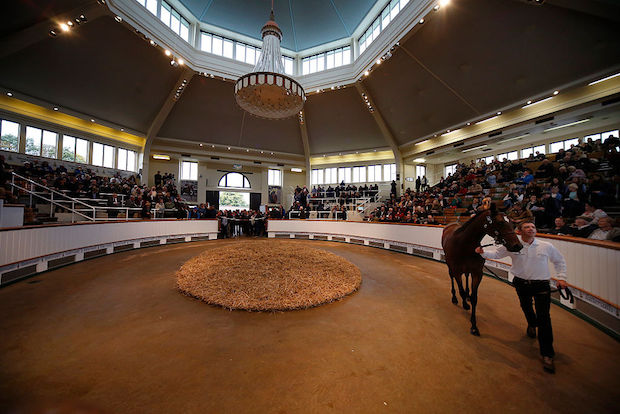No matter how much disruption people might claim that Brexit is bringing to the British economy, in Newmarket at least, the markets don’t seem too bothered. Newmarket is the horse racing capital of the UK, if not the world. And every October thoroughbred yearlings – that is, horses who are classified as being one year old, and will turn two on 1 January 2018 – are auctioned off at a Tattersalls auction in the Suffolk town. It’s Europe’s largest yearling sale, and although not everything comes with a ginormous price tag, there are some fairly hefty sums floating around.
Of course, as they are only yearlings, no one knows what these horses are capable of – all that the bidders have to go on is their pedigree and their appearance. And with racehorses, pedigree is what’s important. That’s why stud fees – the amount it costs to breed your mare to a certain stallion – are so high. Galileo, who stands at the Coolmore stud in Ireland, is the current ‘leading sire’ in Great Britain and Ireland, meaning that his offspring have won more prize money than any other stallion’s in that given year. He isn’t just leading sire this year, though. He has been since 2010, though his first year as leading sire was 2008. As a result, Galileo’s stud fees are – perhaps fairly – the most expensive in the world. Officially they are ‘private’, so no one knows what Coolmore charge. But another stallion Dubawi, who stands in Newmarket, has stud fees of £250,000 – and that price is certainly less than that of Galileo.
So it’s no wonder that at the Tattersalls yearling sales, would-be buyers pore over the youngsters’ bloodlines. The first three ‘books’ of yearlings, which is where the most expensive horses will be found (yearlings are categorised into different ‘books’ based on a range of criteria which includes pedigree) were auctioned off over the past fortnight. Book 1, which is the most prestigious, tends to bring in the most money. Even if many other industries are worried about the financial implications of Brexit, the figures from Tattersalls indicate that in the racing world, the market is still strong. On the last day of Book 1, a filly by the aforementioned Galileo (and out of a top-class winner, Dank), sold for 4 million guineas (£4.2 million). That figure makes that one horse the most expensive one-year-old sold at auction this year, and the second most expensive filly ever sold at a public auction.
That one book of yearlings – a total of 349 horses – created a turnover of over 102 million guineas, with the average price sitting at over 290,000 guineas. Seventeen horses went for over £1 million guineas – almost double the number that reached the £1 million mark last year.
It’s not just at Tattersalls that bloodstock prices are high; the Goffs sale on the eve of Royal Ascot had an average price of £377,083 this year. Those horses, of course, come with the promise of a run at Ascot in the coming week. These yearlings have all that ahead of them. For all the doom and gloom, though, it doesn’t look like the bloodstock industry should be too worried just yet. On the other hand though, anyone looking for a decent racehorse for a bargain price might be better off searching elsewhere.







Comments